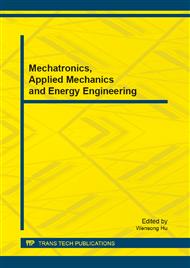p.96
p.101
p.108
p.115
p.121
p.128
p.134
p.140
p.144
The Study of the Vibration Characteristics of the Cantilever Beam with a Surface Crack
Abstract:
In this paper, the physical model of the cantilever beam with a surface crack is established to study the free vibration of the cracked beam from three aspects that are theoretical analysis, FEM analysis, and experiment. At the same time, the relation between the crack parameter and the vibration characteristics, which are natural frequencies and the modes of each order, is obtained through analysis. The theoretical analysis is on the basis of the mode analysis theory and applied mechanics. The crack is regarded as a flexible hinge. Utilizing the external boundary conditions and internal boundary conditions at the crack, the free vibration characteristics are obtained combining with the vibration mechanics. With the ANSYS software, a finite element model of the cracked beam is established by the beam element. During the process of calculation, it calculates the natural frequencies and the modes of cracked beam with different parameters of crack. The results obtained from the experiment are in agreement with the results obtained from the theoretical and the FEM analysis. So the accuracy of the theoretical analysis and the numerical simulation is verified by the experiment. At last, the effects of the crack location and depth on the natural frequencies and modes of each order are shown, and it could provide the theoretical, numerical and experimental basis for the identification of cracked materials and the relevant study.
Info:
Periodical:
Pages:
121-127
Citation:
Online since:
September 2013
Authors:
Keywords:
Price:
Сopyright:
© 2013 Trans Tech Publications Ltd. All Rights Reserved
Share:
Citation:


